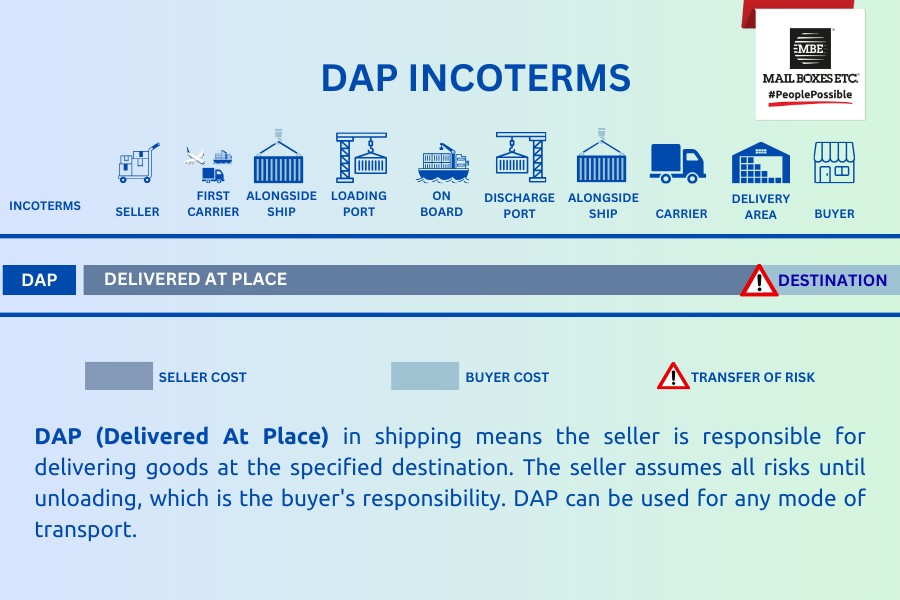DAP Incoterms: What does DAP mean in shipping terms?

Delivered at Place or DAP incoterms are a relatively recent incoterm that has replaced the use of the Delivery Duty Unpaid (DDU) incoterm. Although both are used interchangeably and colloquially, it is the DAP incoterms that are applicable in international shipping today.
In terms of what does DAP mean in shipping terms, the answer is that it is very similar to DDP, except that the seller takes the risk and costs of shipping and delivering goods to a certain location and this responsibility ceases with the unloading of the products. Meanwhile, the buyer will assume the import, value added tax (VAT) and taxes part of the shipping equation before they unload the goods and clear them for import.
DAP in shipping is often used when there are no customs between two countries. An example of this is shipments between two EU countries. A further example of when DAP can be used includes when a seller is unfamiliar with the import clearance procedures at the destination country.
What is Delivered At Place in shipping?
The incoterm delivered at place in shipping or DAP meaning outlines the seller/exporter and buyer/importer’s responsibilities in international shipping. DAP stands for delivered at place in shipping and as an internationally recognised incoterm, it aims to facilitate a smoother and more harmonious method of international shipping in international trade.
In terms of responsibilities, we already mentioned that the seller/exporter carries most of the risk and costs associated with shipping up until the point of loading and import clearance. As for the buyer, their obligations begin when they need to clear the goods for import and when they need to unload the shipment.
Shipments with DAP can be done via practically any mode of transport, including rail, road, ocean or air. In short, this covers the answer to the question of what is a DAP shipment.

Delivered At Place (DAP): Advantages and disadvantages
There are several advantages and disadvantages for both parties using DAP. For example, some of these include the following:
Advantages:
- The buyer understands which party is responsible for paying additional expenses during shipping
- The buyer can better manage their cash flow and inventory
- DAP incoterms can be negotiated, enabling buyers to purchase lower quantities and have them fulfilled more efficiently
- The seller arranges and pays for transportation to an agreed upon place and the risk transfers to the buyer at the point of unloading
Disadvantages
- The seller bears all additional costs during the shipping process
- The buyer is responsible for all risks and losses associated with the goods once ready for unloading
- DAP offers a minimal liability option for buyers, who may wish to place all of the shipping risk on the seller
- In practice, DAP can lead to delays, including customs clearance and there may be additional costs associated with delays, dunnage or detention for the buyer
- DAP is considered a risk for sellers who are exporting to a new buyer because the buyer could refuse to pay import duties and the seller may lose their cargo
- The buyer is responsible for unloading the goods and any further transportation.
- The buyer is responsible for arranging and paying for any import documents and taxes
- The seller is responsible for the loss or damage to the shipment, which means that they need to insure it or pay additional costs should anything occur
- The buyer is likely to shoulder higher costs for the shipment because the seller’s transportation costs are higher
Delivered At Place: Seller and buyer obligations
Both the seller and the buyer have their own obligations when it comes to DAP incoterm agreements.
For example, a seller’s obligations may include preparing the goods, commercial invoice and documentation. They may also be responsible for export packaging and marking. Furthermore, they will need to obtain the necessary export licenses and comply with customs formalities. Other elements that the seller will be responsible for include pre-carriage and delivery, loading charges, the cost of pre-shipment inspection, main transportation, delivery to the destination and proof of delivery.
As for the buyer, they will need to pay for the goods as per the sales contract with the buyer. They will need to unload the goods and attend to import formalities and the payment of the necessary duties. In addition, they will need to pay the cost of import clearance and pre-shipment inspection. Other costs include the onward carriage and delivery.
A common question that frequently arises when it comes to DAP incoterms is who pays for DAP shipping. The answer is that it depends on which part of the process the shipment is at. For example, anything up to just before the unloading of the goods will be considered a seller/exporter’s responsibility, while customs clearance, unloading and any transportation thereafter will be the responsibility of the buyer/importer.
DAP vs. DDP incoterms
Since there are several incoterms or international commercial terms as set out by the International Chamber of Commerce, it is worth noting that the answer to the question of what are incoterms includes the standardization and harmonization of international shipping terminology for greater clarity for all parties involved in international trade.
Although DAP is one way of defining the relationship between a seller and a buyer, another important term is DDP. DDP’s meaning is Delivered Duty Paid and the main difference between DAP and DDP relates to the fact that with DAP, the buyer shoulders some of the costs associated with the shipment (including customs clearance, VAT, taxes, import duties, insurance etc). However, with DDP, these costs are all shouldered by the seller. As such, different incoterms’ meanings place a different focus and burden on each of the parties involved. Therefore, in short, the difference between DAP and DDP is that while both are international commercial terms, one gives the seller a greater burden (DDP) in terms of risks and costs, while the other (DAP) spreads the risk and costs somewhat to the buyer.
When you need DAP shipping, you need the right Denmark logistics company
When it comes to DAP shipping from Denmark, using the right Denmark logistics company is essential. Choosing the right partner for your shipment means that you will face less hassles in exporting to another destination and you will save time, money and significant resources on your shipment. With our expert logistics service, it doesn’t matter whether you need express shipping or ecommerce shipping, we at Mail Boxes Etc. have you fully covered. With the ability to help you with export and import customs clearance in Denmark, DAP shipping to and from Denmark becomes a breeze.
☎ +45 3120 3616
⌨ info@mbedenmark.dk
📍 Østerbrogade 226, st. tv, 2100 Copenhagen, Denmark